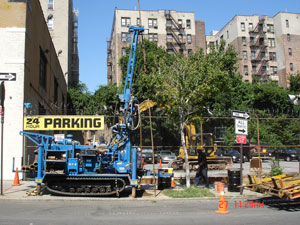 Determining the best way to clean up each Superfund site follows an established process. Following initial scoping, theremedial investigation expands to provide a more in-depth understanding of the site and the sources and extent of contamination, so as to begin developing an appropriate plan to eliminate or contain contamination.
Determining the best way to clean up each Superfund site follows an established process. Following initial scoping, theremedial investigation expands to provide a more in-depth understanding of the site and the sources and extent of contamination, so as to begin developing an appropriate plan to eliminate or contain contamination.
Site characterization augments initial findings through additional field data collection and analysis.
Data Gathering
Remedial investigation uses a wide variety of scientific evidence, surveys, photos and other data to study the site’s:
- Physical characteristics, especially possible migration pathways and receptor populations.
- Contamination sources, including locations, quantities contained or released, physical and chemical characteristics.
- Nature and extent of contamination, particularly the spread and volume of migration and changes to the contaminant’s physical or chemical characteristics.
Although it’s not always possible to precisely understand the full nature and extent of the problem, site characterization is designed to acquire data that:
- Meets the EPA’s Data Quality Objectives (DQOs).
- Identifies potential risks posed by the site.
- Documents whether or not there is a need for remediation.
- Provides enough information to credibly develop and evaluate remedial action options.
Data Analysis
Remedial investigation may use mobile labs, contracted labs or other facilities to analyze data, depending on the volume of work, timing and specific services needed. The results form a baseline risk assessment that identifies the type and level of current or future risks posed by the site that could affect human or environmental health.
A data management system tracks both the quality and the validity of data collected during the investigative process, using field logs, laboratory and quality assurance/control reports.
Finally, site characterization identifies whether additional information is needed to meet the four established criteria noted above.
Following these steps, a preliminary site characterization is prepared. This is a short summary which could be as brief as a list of contaminants and affected media or could be more extensive.
This report provides the supervisory agency with information about potential applicable or relevant and appropriate requirements (ARARs) and helps begin the process of identifying possible remedial actions. The Agency for Toxic Substances and Disease Registry also uses this information to conduct a health assessment of the site. Ultimately, the final clean-up plan will need to balance the most effective technologies and methodologies with available time and resources.
